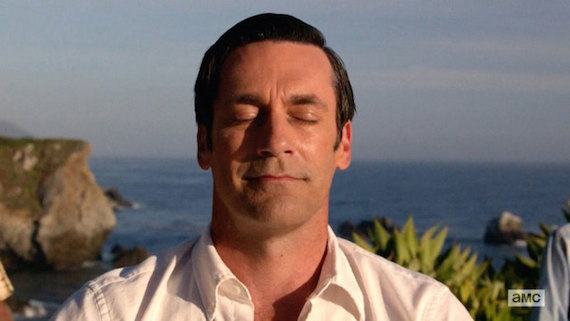SPOILER ALERT: ’Mad Men’ finale—fuzzy and frustrating
Saying goodbye to the show that brought sexy back to advertising
I discovered Mad Men while on summer vacation from college, where I was studying advertising—what else? I joined in around the fourth or fifth season when I ran to the video store, rented all four seasons and spent the summer getting to know Don Draper and the employees of Sterling Cooper.
The storylines, the fashion and the painful yet relatable characters are what pulled me in. The same qualities have made the series an AMC phenomenon and an iconic look back into the Golden Age of Advertising. Don Draper has become a household name, even to those who have never seen an episode of the show. Peggy Olsen and Joan Harris have come to represent working women across the country, and their stories showcase the most blatant representations of struggles that women are still experiencing to this day. Fans were expecting this series finale to be epic—like the show itself—but in typical Mad Men fashion, the finale left many long time fans like myself confused and frustrated.
The most frustrating of all the characters’ final scenes was Peggy. Her sudden romance with friend and co-worker, Stan, seemed completely out of the blue and a little bit soft for the typical nature of her character. Perhaps the Mad Men writers were tying to shine new light on Peggy’s personality through her realization that life isn’t just about work. Then again, I had always pictured Peggy to be the shining example that true love and a great career are not mutually exclusive.
We never do find out if she lives her dream of becoming the agency’s first female creative director (a goal she confesses to Don in a recent performance review). All we know is that she ends up in love with Stan and sticks with her job at McCann Erickson in lieu of starting her own production company with Joan, a decision I don’t think anyone saw coming.
Joan’s conclusion was one of the few that was actually satisfying. To say she has come a long way would be an understatement. Viewers would never expect first-season Joan to become a production company owner. Always the queen of the office, she’s fought many hard battles to climb the ladder in a misogynistic world. Joan has survived an unexpected pregnancy, divorce, and countless rude remarks from her male coworkers—not to mention she was objectified by management to secure Jaguar and McCann Erickson took half of the money she was entitled to as a partner.
Her story ends with her most recent beaux asking her to choose between a relationship with him or starting her business. When Joan tries to reason with him, suggesting she can have both, he leaves her—something we’re used to seeing in Joan’s story. In her last scene we see Joan handing off her son, Kevin, to her mother while she takes the phone from her secretary. Way to go, Joan. I think I speak for feminist fans everywhere when I say we are so proud of you.

Don’s story, on the other hand, was not so optimistic. At the end we see his character come full circle, but not in that he’s grown and become a better man. No, we simply see same old Don, with raw emotion. He is so much the same, in fact, that in Betty’s attempt to keep things “normal” while she dies of cancer, she asks him not to come home from his cross-country trip or even take the children in once she’s gone.
Don confesses the sins of his life in a phone call to Peggy, who has always been there for him when he needs someone to lean on, or someone to tell it to him like it is. She begs him to come home and asks “Don’t you want to work on Coke?” He ends the call paralyzed by the realization of how much he has lost over the years. Conveniently enough, the last we see of the entire series is Don, cross-legged and meditating on a hill in California when a bell rings, and the scene cuts to the iconic “I’d Like to Buy the World a Coke” spot.
For me, this scene (like many other Mad Men scenarios) had me excited, frustrated and a little confused. Are the writers suggesting that Don Draper himself dreamed up this spot? Perhaps he brought the idea back to McCann and had a room of creatives, Peggy included, working on refining this masterpiece—but the spot isn’t really Don’s style, is it? Did McCann produce it without him when he was away? It could be that he really does find inner peace, and had to travel across the country to find that his home, the place he’s most comfortable, is in a suit on Madison Avenue. Whatever the future has in store for Don, the writers of Mad Men left it up for interpretation, like they always have.
Although Mad Men has come to a close, its influence on the advertising industry still lingers. While advertising agencies today are (usually) much more professional, we still have a long way to go with gender equality in the workplace, especially in creative roles. Don Draper brought sexy back to the ad industry and the outside world got a little taste of the work ethic and creativity that goes into creating great ads. The series finale of this epic show definitely took us on an emotional rollercoaster—typical fashion for Matthew Weiner and his crew of Mad Men writers—and it’s definitely not one we’re likely to forget anytime soon.
What did you think of the series finale of Mad Men? We’re you surprised at where the characters ended up? Let us know by tweeting us @SmithandJones1.
